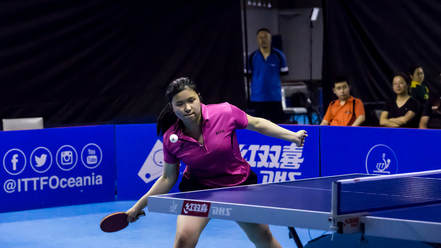 Hui-Ling Vong was one of the first athletes to be selected in the 61-strong New Zealand team for the upcoming 2018 Youth Olympic Games, when she won the International Table Tennis Federation Oceania qualifying tournament in Australia last November. The year 12 Onslow College student will represent New Zealand in table tennis at the Youth Olympic Games (YOG) in Buenos Aires from 6-18 October, alongside boys player Nathan Xu from Saint Kentigern College in Auckland. Hui-Ling has also recently been selected to represent the New Zealand Junior Women’s Table Tennis Team at the Junior World Championships to be held in Bendigo, Australia from 2-9 December, so a busy and exciting time for her is just around the corner. “Right now I am just focusing on the Youth Olympics, they are coming up pretty quick,” she says. “I fly up to Auckland next week for more training and then meet up with the team and we all fly to Argentina next Saturday.” Schoolwork and most recently, exams, aside, Hui-Ling has been training in Wellington most days. “I have been training about 10 hours a week, but am starting to bump this up now. There is on-table training where I play with a partner and just go through exercises and then there is the off-table practice with specific training and fitness.” Fitness is a key component of being a top table tennis player, with rallies and games often taxing affairs, particularly for Hui-Ling, who has an attacking style of play. In winning the Oceania YOG qualifiers she beat New Zealand teammate Jiayi Zhou in a seven game epic, Hui-Ling’s power game prevailing over the defensive skills of Jiayi. But mental skills are also a big part of competitive table tennis. “Much of it is thinking about the different tactics of opponents and combatting different styles such as choppers and defensive players and keeping the pressure on them and keeping cool while you play.” Hui-Ling is expecting tough competition in Buenos Aires. “I know some of the players that will be there, having followed them in past international competitions and on the ITTF website and places like that. I have seen them play and they are pretty amazing.” Table Tennis New Zealand Executive Director John Lea stated that the YOG will be hugely beneficial to Hui-Ling and Nathan. “Hui-Ling has shown a great ability to learn and grow from the experiences she has been presented with. She prepares diligently for the big occasions, with results that demonstrate a rapidly improving ability.” “This is the opportunity for both players to prove to themselves and their supporters that they deserve to be playing on the international stage while they gain the quality table time that is needed to become a world-class player.” The duo will compete in the individual events and will also compete as a doubles pair in the International Team Event. Hui-ling is no stranger to travelling and playing overseas, having represented New Zealand in numerous international events over the last two years, one of the most noticeable was representing New Zealand women's team in the 2016 ITTF World Team Championships. She has also represented Oceania in the 2016 World Cadet Challenge, finishing 16th in the girls singles. “Earlier this year we had an Oceania Junior and Cadet Championship in Rarotonga and I managed to come first in the Junior Girls. Then we had a team tournament after that and I was in a team with a Japanese player and we managed to come third.” Hui-ling started playing table tennis several years ago. “I saw my brother playing and thought the sport was really cool. But I wasn’t competitive back then. I started to get better and I got the opportunity to represent New Zealand at the 2013 World Hopes Challenge when I was 12 and I got to see others playing and from then I wanted to compete on the same level with them. “That was when I fell in love with table tennis and I just wanted to improve and keep playing and it has led me to this point.” Hui-Ling thanked the people who have helped her, not least her parents and coach Li Chun Li and everyone who have helped her practise. “I would also like to thank everyone who has made a donation towards my funding for the competitions I am going to.” She is also looking forward to watching other sports at the YOG when she gets a break from her own competition. “I am looking forward to seeing how the other sports operate and how the athletes prepare and compete and hopefully I can learn from that.” Other wellington sportspeople going to the YOG are 3x3 basketballer Joseph Ahie (also from Onslow College), sevens rugby player Dhys Faleafaga (St Mary’s College) and climber Sarah Tetzlaff (Wellington Girls’ College, 2017).
18/9/2018
NZSS title for fencer Sophia TweddleSophia Tweddle has returned to school from Winter Tournament Week a national champion, having won the Women’s Epee title at the New Zealand Secondary School Fencing Championships in Christchurch.
Sophia has been involved in fencing since primary school but this is her first schools title. “I have been going to the NZSS nationals every year since I started secondary school but this is my first big win,” said Sophia who is year 12 at Wellington East Girls’ College. “While I’ve been getting podium places at national competitions for two-three years now, the NZSS Women’s Epee title is my first national title in any age group.” Sophia is currently ranked first in New Zealand for U17 Women’s Epee, first in NZSS Women’s Epee, third in New Zealand Junior (U20) Women’s Epee and fifth at NZ Women’s Open Epee. Fresh from winning the NZSS title, Sophia is not resting on her sword. “I have got competitions coming up over the next few weeks. This coming weekend I’ll be fencing in an Australian Open competition - AFC 4 - in Sydney, followed by New Zealand Juniors the following weekend and then New Zealand Nationals over Labour weekend in October. So when you add in training camps it’s a long season! And quite a bit of time away from school - which has only been possible because my Dean and teachers at WEGC have been so supportive.” In a field of 11 fencers in the epee competition at the recent NZSS tournament, the first round was a round-robin series (a poule round) where everyone fought each other in bouts that lasted up to three minutes and went up to 5 points. Sophia won eight and lost two. “After the poule round you go into direct elimination and I was seeded third for this. I had the bye in the first round so it was straight to quarter-finals, semi-finals and then the final, and these bouts were up to 15 points.” In these three knockout rounds Sophia beat Zoe Holden (Mount Albert Grammar School) 15-11, second seed Sally Zhang (Kristin School) 15-8 and then top seed Amey Smith (Mount Albert Grammar School) 15-7 in the final. “I had actually already lost to both Sally and Amey in the poule round, so I was nervous going into these. We have up to three three-minute rounds to get to the winning 15 points, but in these I won in two rounds. Before these I struggled with the first bout against Zoe, it got really close but I managed to win at the end.” There were three main individual disciplines at the NZSS nationals, foil and epee and sabre. The foil and sabre are lighter weapons and you can only hit the torso area. The epee is a bit heavier and you can hit all over including the legs and arms. In foil and sabre you have the right of attack but in epee that doesn’t matter. The objective in fencing is to score points with hits. All hits in foil and epee must be with the tip of the blade, but in sabre points scoring with the side of the blade is also valid. “I actually turned to epee from foil more seriously this year. I was training with epee and I did really well in a couple of competitions I entered and I have stuck with it since.” The Men’s Foil at the NZSS nationals was won by Koki Endo of Hutt Valley High School, while Sining Ye from Auckland Girls’ Grammar School won the Women’s Foil, James Butler from Mount Albert Grammar School won the Men’s Epee and Nelson Lee from Macleans College won the Mixed Sabre. There were also teams events, four of which were won by Auckland schools. Sophia is not alone participating in her sport at her school. There is now a small fencing club at WEGC, helped set up by her coach Daniel Chan. There are plenty of opportunities for domestic and international travel in fencing, which is also a long-time Olympic Sport. “In a typical year I will fence in around 15-16 regional, national and international competitions. This year, for example, in addition to regional and national age group and open competitions, I’ve fenced at the Oceania and Australian Juniors in Melbourne, the AFC 1 and Australian U23 Epee in Brisbane, the Asian Zone Cadet and Juniors in Dubai the Australian Cadets in Sydney and the Commonwealth Cadet & Junior Fencing Champs in Newcastle, England in July.” Fast five questions With Sophia: How and when did you start fencing? “My dad did it and my brother was doing it so I went along and joined in. I started in year 6 and took it up seriously when I started college. I was doing other sports, and I was a competitive swimmer up to that point.” How much time does training and practice take up? “There are two strength and conditioning programmes a week. Then there’s training sessions that involve hand coordination and footwork and then fencing. How much of fencing is mental? Much of it is in the mind, it is like physical chess, so lots of concentrating. What is the equipment you wear? For my specific discipline, epee, it requires full length protection as you can attack anywhere on the body. The basic gear everyone will have is breeches [pants], shoes, knee-high socks, a chest protector, arm protector a jacket over that, gloves a mask, the wire and then the epee, which is the actual weapon. Do you get injuries? The gear does protect you, but we often get a few bruises on our legs and arms, you get used to it! We have got a wire and when you hit the target a light will come up so you don’t need to be too hard on attack. 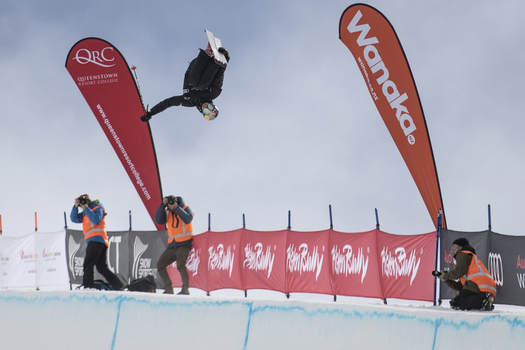 Nico Porteous: Iain McGregor/Winter Games NZ via AP Nico Porteous: Iain McGregor/Winter Games NZ via AP New Zealand skier Nico Porteous has won the FIS Junior Freeski Halfpipe World Championships 2018 title at his home mountain of Cardrona Alpine Resort. The 16-year-old, who claimed an Olympic bronze medal in PyeongChang earlier this year, went in to today’s Audi quattro Winter Games NZ competition as the top qualifier. However, a deep landing on his switch 1080 on his first run of three initially had him sitting in second place behind Norway’s Birk Ruud. Porteous came through with a 93.80 on his second attempt, cleaning everything up and executing a technical run with a left double 1260 and an alley-oop flat spin 540 on his last hit for the lead. “This means a lot,” said Porteous. “It’s my first Junior World Champs and to come away with the win is really cool. “It’s all about going forward from now on.” Another local skier, Ben Harrington made a strong challenge for the podium, holding on to third place until the third last run of the day, when USA’s Dylan Ladd came through with big back to back 900s at the top of the pipe and finished with a super technical double flat 900 down the pipe for a score of 92.80, pushing Harrington in to fourth place and Ruud in to third. Top qualifier in the women’s freeski halfpipe, Kelly Sildaru faced a strong challenge by Russia’s Valeriya Demidova who showed excellent trick variety and execution with back to back left and right flairs with good amplitude and grabs. However, no one looked more at home in the pipe nor matched the amplitude, grabs and trick execution of Sildaru and she led the field on all three of her runs, finishing her day as the Junior World Halfpipe Champion. “I’m really happy with my run,” said Sildaru. “Today I did my first nines since my injury (a year ago) so I’m pretty stoked.” China’s Kexin Zhang claimed the bronze medal. American rider Toby Miller, competing at his fourth FIS Junior World Champs Halfpipe and with two silver medals (2017, 2015) already in the trophy cabinet, landed the gold medal in men’s snowboard. Miller landed his winning score of 93.20 on his first run of three, opening with a frontside double 1080 stalefish to cab double 1080 melon grab, and closing out with a frontside 1080 tailgrab. “I couldn’t be happier,” said Miller. “The level of riding out here today was absolutely-phenomenal, all the riders are so talented. This is my fourth Junior Worlds and every year the level just gets higher and higher, I’m honoured to be in such an elite group of riders.” Japan’s Ruka Hirano jumped into the silver medal spot on his third run, also incorporating three 1080s in his run and scoring 89.60, not quite matching Miller’s amplitude or clean trick execution. Team mate Kaishu Hirano finished in the bronze medal position. Mitsuki Ono (JPN) claimed the junior women’s Snowboard Halfpipe title, landing three solid runs, all of which scored above her competitors’ but sealing the deal with a score of 85.80 on run three and confirming that she was “very happy” with her performance Tessa Maud (USA) finished second and Elizabeth Hosking (CAN) third. Competition continues at Cardrona Alpine Resort tomorrow (Wednesday) with the FIS Freeski Big Air World Cup qualifiers and Snowboard Parallel Giant Slalom. |
CategoriesArchives
March 2022
|
OrganisationCollege Sport Media is dedicated to telling the story of successful young sportspeople in New Zealand
|

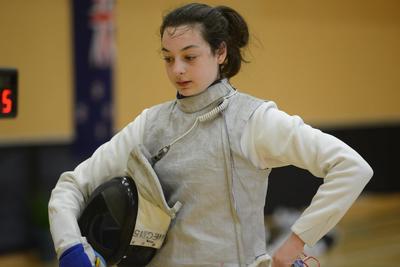
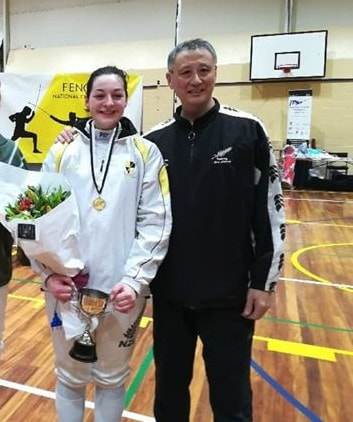
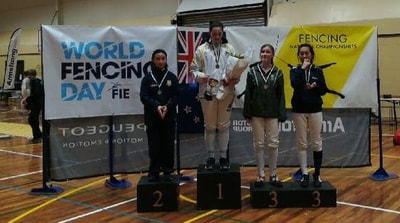

 RSS Feed
RSS Feed